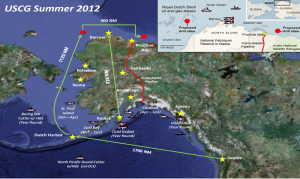2012-10-15 Recently, Rear Admiral Thomas P. Ostebo, Commander of the USCG, 17th District, appeared before the US Senate and provided an overview on recent USCG activity in the Arctic.
(For the complete testimony read the document below:
Notably, the Admiral provided a succinct overview on Operation Arctic Shield 2012:
Arctic Shield 2012 was a three pronged interagency operation in Alaska’s coastal Arctic domain consisting of outreach, operations, and assessment of capabilities from February through October 2012. Outreach was comprised of delivering education, awareness and health services for Arctic communities and outlying native villages.
Operations involved deployment of major cutter forces, air assets, communication equipment, and mission support to conduct the Coast Guard’s missions. Assessment of capabilities involved an analysis of our front-line operations and mission support assets in Arctic conditions.
Additionally, an oil spill contingency exercise in Barrow, Alaska, tested Coast Guard and Navy skimming equipment launched from a 225-foot Coast Guard buoy tender. Arctic Shield 2012 was carefully tailored to deliver the appropriate set of capabilities to this remote area. I am very proud of our team in the Seventeenth Coast Guard District for bringing the Arctic Shield plan to fruition.
The following unclassified schematic outlined our planned force lay down for Arctic Shield 2012. The graphic demonstrates our key challenge – moving Coast Guard resources from our long-established bases in south Alaska to the emerging frontier of northern Alaska.
For the first time, we had two MH-60 helicopters in Barrow standing the watch and ready to respond. This meant that, readiness and weather permitting, we could meet a 30-minute launch window for imminent missions such as search and rescue, environmental protection and law enforcement. The following photo shows the MH-60’s in their leased hangar in Barrow.
We deployed USCGC BERTHOLF, the first National Security Cutter, to the southern Arctic region, providing persistent operational presence, and command and control, in areas where we lacked the permanent infrastructure of a coastal Sector. We also deployed two light-ice capable 225-foot ocean-going buoy tenders to increase offshore operational capability in the region.


